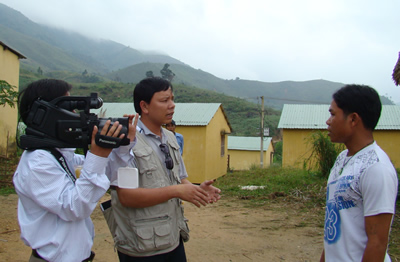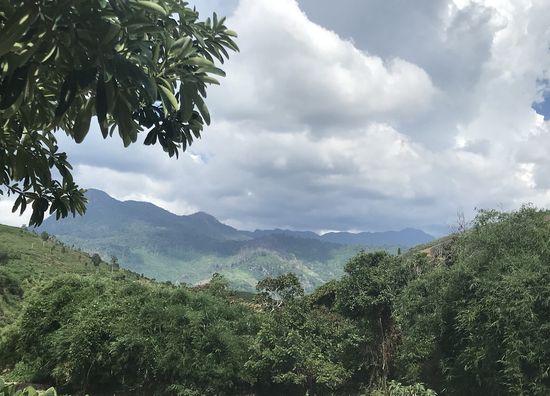Transfer of land-use rights from the state to the community…
Hydropower Trend in Vietnam: The Less Mentioned Social and Environmental Side-Effects
Vietnam has good potentials for hydropower development with the watershed system consisting of more than 2,000 rivers and streams. In theory, hydropower can supply about 308 billion Kwh of electricity. Vietnam’s technical hydropower reserve of plants over 10 MW is 72 billion Kwh. There are about 360 sites suitable for installing hydropower plants with total capacity of 17.500MW (1). This does not include other hydropower plants of smaller sizes.
Currently, hydropower accounts for a large portion of electricity production. The development strategy of Vietnam’s electricity industry in the period of 2006 – 2015 with orientation toward 2025 also gives priority to the development of hydropower and encourages investment in small-sized hydropower plants. It is estimated that by 2020, the total capacity of hydropower plants shall reach around 13,000-15,000 MW. However, according to the estimation of the Institute of Energy, over the long term, the percentage of capacity and power generation of hydropower will reduce significantly in comparison with other energy sources. It is estimated that by 2025, hydropower capacity will hold only 24.1% (44% in 2005) and power generation will account for 14.1% (30.8% in 2005).

Electricity production by sources. Source: Electricity of Vietnam www.evn.com.vn (Retrieved September 1st, 2008)
One of the most difficult and complicated issues in developing hydropower projects is human resettlement for communities affected by plant and reservoir construction, especially ethnic communities in remote areas. In fact, this is a common challenge for many countries having hydropower development. Consultation of these communities during the project planning and implementing process is an important step to safeguard benefits of affected groups and prevent potential unwanted conflicts.
The current development strategy for hydropower with many projects being planned and carried out at the same time in short term faces great challenges. To date, there are not yet many successful models for human resettlement and provision of alternative sustainable livelihood in Vietnam. Therefore, decision makers and project implementers need to concern and learn from experiences in other countries. In addition, there should be well-planned interventions for capacity building for affected communities and providing supports for these communities more effectively in order to ensure that benefits from hydropower development must go first to those live close to the project sites.

In April 2008, PanNature’s communication team and associate journalists carried out field investigation in hydropower projects in Quang Nam province.
Hydropower plants are often constructed in areas with high ecological sensitivity, where can suffer serious environmental changes at large scale under construction activities. The feasibility study stage of these projects also involves environmental impact assessment. However, quality and transparency of these reports are questionable. Many reports describe environmental issues and problems resulted from construction process of hydropower plants but provide little information on proposed screening solutions or mitigation measures. Furthermore, the requirements for ongoing environmental assessment and monitoring during the project implementation are not yet well defined in current legislation.
According to the assessment of the Vietnam Union of Science and Technology Associations (2), hydropower development can cause many environmental impacts and affect water resource use, specifically:
- Risks of degradation and exhaustion of water sources caused by altering water flows and combining water basins for providing sufficient capacity for power plants.
- Downstream of rivers where hydro plants are built will dry up after the construction finishes. Many projects cause drought at river downstream in wide scale, thus posing impacts on agricultural production and households’ water use in these areas.
- Risks of sedimentation in hydropower reservoirs are not yet well assessed. Deposits in reservoirs can cause reduction or loss of important sources of fertile alluvia in downstream areas.
- Reservoir systems can flood large areas, change natural ecosystems, cause negative impacts on biodiversity and create micro-climate changes in flooded areas.
- Risks of stimulating earthquakes caused by the reservoir formation have not been assessed and forecasted.
Social and environmental aspects in small-sized hydropower projects need more attention and concerns of policy makers and government authorities. With low investments and pressure of quick capital withdrawal, project investors are more willing to bypass some phases, process, or requirements to keep up the project progress. According to the Ministry of Industry and Trade, in 2008, 39 small-sized independent hydropower plants (often referred to as IPPs) with total capacity of over 43MW will go into operation (3). At the beginning of April 2008, there were 217 IPPs with capacity of nearly 4.100MW registered by private companies, joint venture companies and state corporations. In fact, some of these projects don’t properly comply with requirements to ensure the social and environmental benefits that have faced objections and disagreements from local communities and authorities.
Several small-sized hydropower projects in Ha Tinh province mentioned in a series of featured articles “Hydropower: Development and Trade-off†published on PanNature’s environmental news website www.ThienNhien.Net demonstrate different angles of these issues.

Another loop-hole in development of small-sized hydropower plants involves some inventors taking advantage of these projects to appropriate natural resources. Several hydropower projects are merely cover-ups for inventors to exploit forest products in watershed primary forests, which are strictly protected by existing laws. This loop-hole is being used in many projects. Some articles in the series on Vietnam’s hydropower published on www.ThienNhien.Net also cover this aspect.
(1) Vu Duc Khanh. Status of exploitation and use of natural resources. Statistical Science Journal, Vol.4/2005
(2) Vietnam Union of Science and Technology Associations. Assessment of Vietnam Power Development Plan. April 2007.
(3) http://www.vnanet.vn/TrangChu/VN/tabid/58/itemid/247826/Default.aspx

